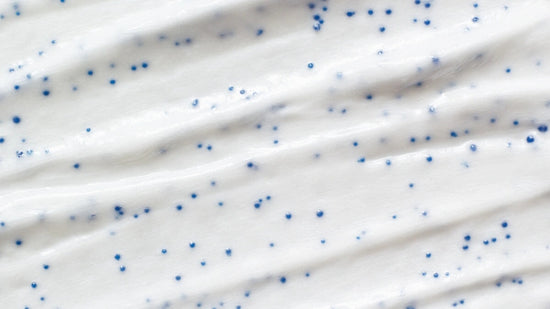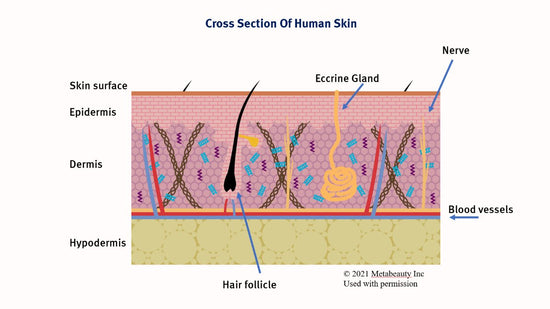Exfoliation vs Desquamation of Skin
Desquamation and exfoliation of the skin are the processes by which old dead skin cells are removed from the skin's surface. Desquamation and exfoliation are responsible for keeping the skin surface smooth and glowing from reflected light.
When the desquamation process is not functioning properly, dead skin cells build up on the skin's surface, making it look dull and "old" and lifeless.
Exfoliation and desquamation of skin occur when cells from the top outer layer of the skin known as the stratum corneum are removed.
This blog will discuss what desquamation is and why desquamating skin cells are a good thing in healthy skin. When skin cells cannot desquamate properly, acne, rough skin, and ashy skin can result. Some skin diseases are characterized by excessive desquamation. This blog will limit the discussion to healthy skin and how skin care products affect desquamation.

Desquamation vs Exfoliation
The words exfoliation and desquamation are often used interchangeably, but they do not have the same meaning. Desquamation happens naturally while exfoliation is caused by an external force such as an exfoliant or friction.
Desquamation
The definition of desquamation is the normal skin cycle of keratinocyte skin cells being born from stem cells at the basal layer of the epidermis, maturing, changing and flaking off at the skin's surface.
Exfoliation
Exfoliators can be used to help the skin complete the desquamation process and smooth skin. Exfoliation is when you use an exfoliant to speed up the skin's natural desquamation process.

Keratinization
Keratinization is the skin cell's life cycle, wherein cells in the outermost layer of the skin (epidermis) produce a protein called keratin.
Keratinization begins in the basal layer of the epidermis. As these keratinocyte skin cells migrate towards the skin surface, they begin to fill with keratin, This keratin-enriched top layer of the skin, the stratum corneum, acts as a protective shield against external environmental factors, such as pathogens and physical abrasions.
While keratinization is about the formation and maturation of skin cells, desquamation focuses on the removal of old, dead cells from the skin's surface. Both processes are intricately linked and play a pivotal role in maintaining the skin's health and integrity.
Layers of the Epidermis Where Exfoliation Occurs

What is skin keratinization?
Keratinization is the process of keratinocyte cells being "born" from stem cells and moving slowly through the layers of the skin to the skin's surface. Keratinization results in the formation of skin, hair and nails. Keratin is a strong protein made by the skin's keratinocytes.
Removing cells from the outermost layer of the epidermis (known as the stratum corneum ) triggers stem cells in the basal layer to begin dividing and making new cells.
In other words, desquamation and exfoliation trigger the development of new skin cells in the basal layer of the epidermis. Normal desquamation is necessary to keep skin smooth, radiant and glowing.
Dehydrated skin has impaired exfoliation. Exfoliators can be used to speed up the desquamation of the skin, but overuse of exfoliators can cause skin dehydration and inflammation.
When you do not use the right products for your Baumann Skin Type, or if you over exfoliate, you can disturb the desquamation process and hurt the health of your skin. You can take our skin type quiz to find out which products are bet for your skin type.
What is the Difference Between Exfoliation and Desquamation?
Exfoliation and desquamation both result in the same endpoint- the removal of cells from the outermost layer of the stratum corneum of the epidermis.
The difference in desquamation and exfoliation is how the outermost dead layer of SC skin cells is removed.
Desquamation is a natural process while exfoliation depends upon the use of exfoliators.
To understand the difference between exfoliation and desquamation, you must also learn the definition of keratinization.
Definition of Keratinization

The meaning of keratinization is the process of skin cells being “born” from stem cells in the basal layer of the epidermis and maturing and moving up to the top layer of the skin known as the stratum corneum.
The word keratinization comes from the skin protein keratin that is made by the epidermal skin cells (called keratinocytes).
Keratin is a structural protein found in skin, hair and nails that provides strength.
Different layers of the skin make different types of keratin.
The word keratinization comes from the fact that as the keratinocyte skin cells mature, the type of keratin they make changes.


Definition of Desquamation
“Squam” means “skin cell” and comes from the Latin word “squama” meaning “the scale of the fish” (because scaly skin looks like fish skin).
Desquamate is the word used to describe when cells flake or scale off of the skin. Desquamation is the naturally occurring process when the attachments between skin cells that hold them together are dissolved by enzymes. This loosens the attachments between skin cells and allows them to “desquamate” into the environment. Desquamation is a natural unaided process.

Definition of Exfoliation
Exfoliation is when exfoliators are used to enhance desquamation.
Exfoliators such as scrubs, hydroxyacids, microdermabrasion and facial brushes help loosen cell attachments to speed the desquamation process.
Controlling exfoliation with skincare products can give you glowing healthy skin, but you need to make sure you are using the correct skincare routine steps for your Baumann Skin Type.

Best References and Scientific Publications on Exfoliation and Desquamation:
- Baumann L. Epidermis in Ch. 1 of Baumann's Cosmetic Dermatology Ed 3. (McGraw Hill 2022)
- Pierard, G. E., Goffin, V. E. R. O. N. I. Q. U. E., Hermanns-Le, T. R. I. N. H., & Pierard-Franchimont, C. L. A. U. D. I. N. E. (2000). Corneocyte desquamation. International journal of molecular medicine, 6(2), 217-238.
- Milstone, L. M. (2004). Epidermal desquamation. Journal of dermatological science, 36(3), 131-140.
- Has, C. (2018). Peeling skin disorders: a paradigm for skin desquamation. Journal of Investigative Dermatology, 138(8), 1689-1691.
- Zani, M. B., Sant'Ana, A. M., Tognato, R. C., Chagas, J. R., & Puzer, L. (2022). Human tissue kallikreins-related peptidases are targets for the treatment of skin desquamation diseases. Frontiers in medicine, 8, 777619.
- Trevisol, T. C., Henriques, R. O., Souza, A. J. A., & Furigo Jr, A. (2022). An overview of the use of proteolytic enzymes as exfoliating agents. Journal of Cosmetic Dermatology, 21(8), 3300-3307.
- Matoltsy, A. G. (1976). Keratinization. Journal of investigative dermatology, 67(1), 20-25.
- Hambrick Jr, G. W., Lamberg, S. I., & Bloomberg, R. (1966). Observations on keratinization of human skin in vitro. Journal of Investigative Dermatology, 47(6), 541-550.
- Mayer-da-Silva, A., Gollnick, H., Detmar, M., Gassmüller, J., Parry, A., Müller, R., & Orfanos, C. E. (1989). Effects of azelaic acid on sebaceous gland, sebum excretion rate and keratinization pattern in human skin. An in vivo and in vitro study. Acta dermato-venereologica. Supplementum, 143, 20-30.
- Friedman-Kien, A. E., Morrill, S., Prose, P. H., & Liebhaber, H. (1966). Culture of adult human skin: in vitro growth and keratinization of epidermal cells. Nature, 212(5070), 1583-1584.

















































